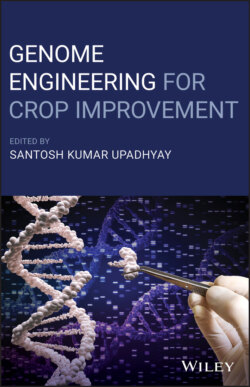Читать книгу Genome Engineering for Crop Improvement - Группа авторов - Страница 11
Preface
ОглавлениеAbout half of the world population is suffering from nutritional deficiency, which is due to either improper diet uptake, or non‐availability and unaffordability of balanced nutritive food. Therefore, nutritional enrichment of common food items has been of great interest to fulfill the demands of nutritional deficiency. For instance, development of carotenoids‐rich banana and tomato, and iron‐rich rice and wheat has been proposed to solve major issues of vitamin A deficiency and anemia. Further, the distribution of important mineral elements in grains is also a major challenge for their bioavailability. For example, the majority of elements like iron are enriched in the aleurone layer of wheat grain and, therefore, it is not in flour for consumers. These are the major challenges which can be addressed by utilizing genome‐engineering mechanisms.
Genome engineering has been evolved as an efficient method for targeted mutation and modification in the genome of various organisms. During the last decade, genome engineering has been utilized for numerous trait improvement programs in several important crop plants. Genome‐engineering tools like ZFNs, TALENs, and CRISPR‐Cas system have been used for in‐vivo gene editing, as well as much biological pathway engineering for the nutritional improvement of various agricultural and horticultural crop plants. They have been of greater interest due to their precise editing mechanisms and very high specificity. Over the past few years, they have been utilized in numerous agricultural and horticultural crop plants including rice, wheat, legumes, tomato, potato, banana, grapes, etc. They are found to be highly specific and precise in their function. They have also been used for the engineering of numerous metabolic pathways to develop nutrient‐rich produce. They are used to decrease the anti‐nutrients in crop plants to improve bioavailability of minerals and vitamins, development of zero calorie/ sugar‐free potato, indigestible starch‐rich grains, allergenic gluten‐free wheat and various other processes. Further, they can also be used for the mobilization of minerals from unavailable locations to the bioavailable location for grains.
Researchers have been working hard to increase the nutritional value of various important crop species by increasing the nutraceuticals and minerals such as carotenoids and flavonoid‐rich cereals, tomato and fruit crops, iron‐enriched rice, maize, and wheat, etc. On the other hand, people are also working to decrease the anti‐nutrients such as phytic acids and other chelating elements in crops to increase the bioavailability of the available micronutrients. Further, development of sugar‐free potato and gluten‐free wheat, resistant starch rich rice and wheat is in great demand by people suffering from various diseases or as preventive measures.
The development of new strategies to cope up with the various challenges has always been a top priority over recent years. Agronomical practices, chemical applications, biofortifications and transgenic expression of protein‐coding genes have been explored to alleviate these problems to some extent. However, new and specific technology is always in demand. Genome engineering can be the best alternative for nutritional improvement of agricultural and horticultural crops. Further, it will be highly specific to a particular gene and plant, therefore, it has minimal bio‐safety risk. Taking this, together with progress made in crop improvement using genome engineering methods, this book has covered all the recent knowledge and development in the area related to the nutritional value, mineral and nutrient localization, and engineering for stress resistance as well as nutritional improvement of various crop plants. None of the currently available books have covered this topic at such a broad scale. Further, this area is of tremendous importance, not only in the present scenario but also for future decades.
Much effort has been made by all those involved to provide a well‐informed and knowledgeable book. I hope that this stimulates discussion and inspires future research and discussion on such an important topic.
